The intensifying conflict between Iran and Israel is raising serious concerns over the safety of global trade routes and energy supplies. As the situation escalates, analysts warn of severe repercussions for the global economy, particularly if strategic maritime passages like the Strait of Hormuz and Bab el-Mandeb are compromised.
Experts highlight that any disruption to these chokepoints - through which a significant portion of the world’s oil and gas flows - could send shockwaves through international markets.
Rising insurance premiums, increased shipping costs, and a potential surge in energy prices are among the immediate risks. Such instability could accelerate global inflation and weaken already fragile economic growth, especially as major economies face tariff-related pressures and slowing demand.
According to Dr. Fawaz Al-Alamy, a specialist in international trade, the continuing geopolitical unrest is likely to slow global trade growth by over 7% in 2025 and 2026. Sea freight, which carries about 90% of global trade, is particularly vulnerable. Dr. Al-Alamy also points to revised forecasts from major institutions, with trade growth now expected to drop to 2.9% in 2025 and possibly lower in 2026.
The Gulf region, which last year ranked sixth globally in merchandise trade, faces specific challenges. The Strait of Hormuz alone handled over 25% of global seaborne oil and 20% of LNG shipments in 2024 and early 2025. A disruption here would hit Asian markets hardest, as China, India, Japan, and South Korea together receive nearly 70% of Gulf crude exports.
The United States also imports around 500,000 barrels per day from the Gulf via Hormuz, about 7% of its total crude imports. A supply interruption could double oil prices and drive maritime shipping costs up by 60%, leading to slower global growth, reminiscent of post-COVID economic conditions.
Still, Al-Alamy sees potential for regional cooperation. Gulf states could invest in alternative export routes through the Arabian Sea and Red Sea, and strengthen trade ties with Asia, Africa, and Europe. Logistics and tech investments may also help the region emerge as a global trade hub.









